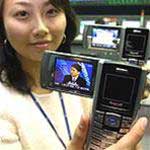 |
|
Satellite TV Integrated Phone – A Product from Samsung |
The internet is omnipresent, enveloping everyone in a global network. Wireless connectivity through distinct identifiers, known as “Radio ID Tags,” liberates individuals from tangled wired systems.
This innovation allows people to check whether they should buy a certain type of wine to pair with the fish they currently have or if the fish has reached safety standards.
This vision of future innovations was showcased last Tuesday alongside the Asia-Pacific Cooperation Summit. South Korean organizers provided the heads of state with an opportunity to participate in the first trial of a wireless internet service named “WiBro.”
This technology is based on the WiMax standard, a new wireless technology rapidly developing worldwide. WiBro allows users to browse the web, watch movies, and make calls over the internet. It is expected that WiBro will be widely available next year for end-user devices such as phones, laptops, and compatible expansion cards. WiBro is part of South Korea’s plan to build an “ubiquitous information society.”
Information and Communication Minister Chin Dae-je told reporters: “We will live in a world of knowledge and robots.”
The highlight of the presentation was a 137 cm tall robot with two legs and a head resembling scientist Albert Einstein, named “Albert Hubo.” With 31 internal motors, Albert Hubo can smile and wink charmingly, and even frown at anyone who touches its head.
Additionally, the presentation featured many digital products and multimedia high-tech technologies such as satellite TVs and mobile phones. A series of digital products utilizing Radio ID Tags technology were also showcased.
A wireless world filled with various high-tech products will envelop our future world not too far from now.
T3T


















































